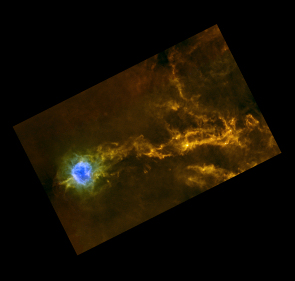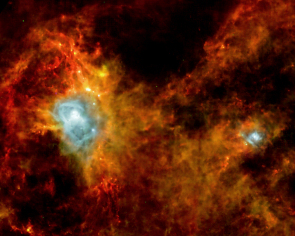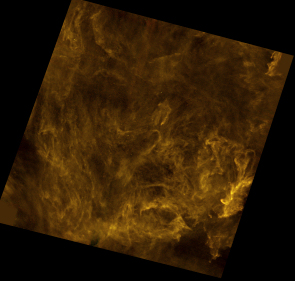Herschel unravels the thread of star formation in the Gould Belt
13 April 2011
An intricate network of filamentary structure, exposed in extraordinary detail by the Herschel Space Observatory, has provided new evidence for how stars form from the diffuse interstellar medium. These filaments, located in giant molecular clouds in the Gould Belt, all exhibit remarkably similar widths - about one third of a light year - but only the densest ones contain pre-stellar cores, the seeds of future stars. These data suggest star formation is a two-step process: first turbulence stirs up the gas, giving rise to a web-like structure, then gravity takes over and governs the further fragmentation of filaments into stars. |
| The star-forming cloud IC 5146. Credit: ESA/Herschel/SPIRE/ PACS/D. Arzoumanian (CEA Saclay) for the "Gould Belt survey" Key Programme Consortium |
Giant molecular clouds are huge complexes of gas and dust characterised by a very low density, even thinner than air. Many of these clouds are the sites of stellar birth, but how this diffuse mixture condenses into compact cores, which later evolve into stars, is still an open question in astrophysics.
"Filaments are the first structures to develop in the fragmentation process of molecular clouds, hence they're the objects to watch when investigating the very early stages of stellar formation," explains Philippe André from the Commissariat à l'énergie atomique et aux énergies alternatives (CEA), France. André is Principal Investigator for a Herschel Key Programme focussing on the Gould Belt, a giant ring of stars and star-forming regions in the vicinity of the Sun.
Many examples of interstellar filaments were known prior to the launch of Herschel, but their role in the context of early star formation was still unclear. By mapping large portions of the Gould Belt to unprecedented accuracy, André and his colleagues plan to shed new light on this and other issues concerning the initial phases of how stars are born. "The picture emerging from Herschel's first observations of this region shows that filaments are more than just important: they're everywhere," he adds.
The first three Gould Belt complexes to be analysed in detail - the Aquila Rift, IC 5146 and the Polaris Flare - are molecular clouds characterised by different degrees of star formation activity: very intense in the case of Aquila, less so in IC 5146 and almost absent in Polaris. The stunning images delivered by the cameras on Herschel reveal a rich network of filamentary structure in all three regions, regardless of their gravitational status or whether or not they are actively producing stars.
 |
| The Aquila Rift. Credit: ESA/Herschel/SPIRE/PACS/ Ph. André (CEA Saclay) for the "Gould Belt survey" Key Programme Consortium |
"Curiously, our study shows that all interstellar filaments detected in the three regions tend to have a typical width of about 0.3 light years," comments Doris Arzoumanian, also from CEA, who led the effort of characterising these three complexes in great detail. "This finding highlights that something must be going on at this particular scale," she adds.
Herschel's excellent sensitivity provides astronomers with the possibility to inspect the clouds for both filaments and compact cores. This allowed the team to probe the connection between these two types of structure that mark the early phases of star formation. The data have disclosed a wealth of 'starless cores' embedded within the filaments in all three clouds: some of these compact objects are physically bound by gravity and thus on their way to becoming stars, whereas others are simply regions that are denser than their surroundings, but where the matter is unbound.
"Most of the compact cores that we have detected in the Aquila Rift are gravitationally bound, pre-stellar core candidates. IC 5146 contains many bound cores as well. In contrast, almost all cores we've identified in the Polaris Flare are unbound," notes Arzoumanian. Furthermore, all pre-stellar cores found in both Aquila and IC 5146 appear to reside in the densest filaments: this, along with the indication that all filaments have the same width, suggests the existence of a minimum mass threshold above which a filament starts to collapse under its own weight, eventually resulting in the production of stars.
The analysis of all three regions shows that filaments precede star formation and, in some cases, pave the way for it. The Polaris Flare, with its intricate web of interstellar filaments, none of which appear to be above the mass threshold, offers an example of the state of a molecular complex prior to the onset of star formation. In contrast, the other two regions are in a more advanced stage. "Deciphering the details of how stars are born is one of Herschel's main objectives," comments Göran Pilbratt, Herschel Project Scientist at ESA. "This result contributes to this by proposing a possible explanation for why some molecular clouds are stellar factories and others are not."
On the one hand, the study establishes the ubiquitous nature of filaments in molecular clouds; on the other, it identifies mass as the critical parameter determining whether or not a filament will produce stars. This suggests that two distinct, sequential mechanisms drive the fragmentation process that turns the diffuse texture of molecular clouds into proto-stars: first turbulence, then gravity.
"We believe that the tangle of filaments is generated by turbulent gas dynamics in the clouds," explains André. "This provides also a justification for the 'universal' width observed in the filaments, which corresponds to the typical scale where interstellar gas undergoes the transition from supersonic to subsonic state," he adds.
In such a scenario, gravity would intervene only at a later stage, taking the lead in driving the cloud's evolution from that point on. Under the effect of gravity, the densest filaments would grow progressively more massive by accreting matter from their surroundings, subsequently fragment into isolated, self-gravitating cores and eventually develop into stars. Further observations and theoretical modelling of filaments are needed to provide additional evidence for this scenario and to gain an even clearer understanding of the processes at play in giant, star-forming, molecular clouds.
Notes for editors
The study presented here, and published today in Astronomy and Astrophysics, is based on observations performed within the Herschel Key Programme "Probing the origin of the stellar initial mass function: A wide-field Herschel photometric survey of nearby star-forming cloud complexes" which aims at mapping large portions of the Gould Belt with the SPIRE and PACS instruments on Herschel. The survey will cover the wavelength range 70–500 μm in order to study the demographics of star formation and the details of its onset. When completed, the entire survey will comprise about 20 star-forming regions.
The first three regions to be analysed in detail are: the Aquila Rift, a very active star-forming complex at a distance of about 850 light years; the Polaris Flare, a translucent cloud with little to no star formation at a distance of about 490 light years; IC 5146, a star-forming cloud at a distance of about 1500 light years.
The Aquila and Polaris fields were observed during the Science Demonstration Phase at the end of 2009; IC 5146 was observed on 29 May 2010. All three fields were observed in the parallel scan mode of Herschel with both SPIRE and PACS.
Herschel is an ESA space observatory with science instruments provided by European-led Principal Investigator consortia and with important participation from NASA.
The SPIRE instrument contains an imaging photometer (camera) and an imaging spectrometer. The camera operates in three wavelength bands centred on 250, 350 and 500 μm, and so can make images of the sky simultaneously in three sub-millimetre colours. SPIRE has been developed by a consortium of institutes led by Cardiff Univ. (UK) and including Univ. Lethbridge (Canada); NAOC (China); CEA, LAM (France); IFSI, Univ. Padua (Italy); IAC (Spain); Stockholm Observatory (Sweden); Imperial College London, RAL, UCL-MSSL, UKATC, Univ. Sussex (UK); Caltech, JPL, NHSC, Univ. Colorado (USA). This development has been supported by national funding agencies: CSA (Canada); NAOC (China); CEA, CNES, CNRS (France); ASI (Italy); MCINN (Spain); SNSB (Sweden); STFC (UK); and NASA (USA).
PACS is also an imaging photometer (camera) and an imaging spectrometer. The camera operates in three bands centred on 70, 100, and 160 μm, respectively. PACS has been developed by a consortium of institutes led by MPE (Germany) and including UVIE (Austria); KUL, CSL, IMEC (Belgium); CEA, OAMP (France); MPIA (Germany); IFSI, OAP/AOT, OAA/CAISMI, LENS, SISSA (Italy); IAC (Spain). This development has been supported by the funding agencies BMVIT (Austria), ESA- PRODEX (Belgium), CEA/CNES (France), DLR (Germany), ASI (Italy), and CICT/MCT (Spain).
Related publications
Arzoumanian, D., et al., "Characterising interstellar filaments with Herschel in IC 5146", A&A, 529, L6 (2011), DOI: 10.1051/0004-6361/201116596
André, Ph., et al., "From filamentary clouds to prestellar cores to the stellar IMF: Initial highlights from the Herschel Gould belt survey", A&A, 518, L102 (2010), DOI: 10.1051/0004-6361/201014666
Contacts
Doris Arzoumanian
Laboratoire AIM Paris-Saclay
CEA/IRFU
Gif-sur-Yvette, France
Email: doris.arzoumanian cea.fr
cea.fr
Phone: +33-(0)169082508
Mobile: +33-(0)618743613
Philippe André
Laboratoire AIM Paris-Saclay
CEA/IRFU
Gif-sur-Yvette, France
Email: pandre cea.fr
cea.fr
Phone: +33-(0)169089265
Göran Pilbratt
Herschel Project Scientist
Research and Scientific Support Department
Science and Robotic Exploration Directorate
ESA, The Netherlands
Email: gpilbratt rssd.esa.int
rssd.esa.int
Phone: +31 71 565 3621




